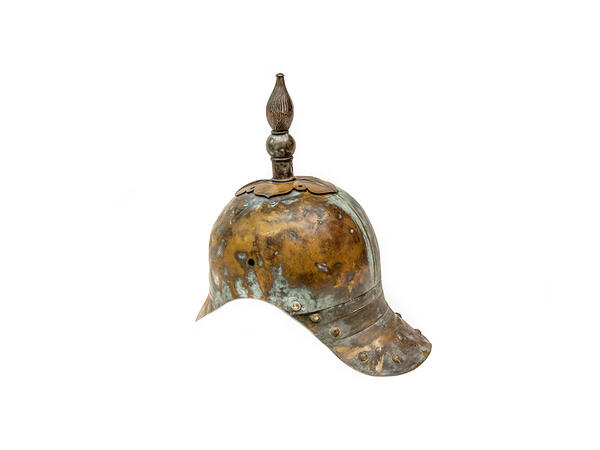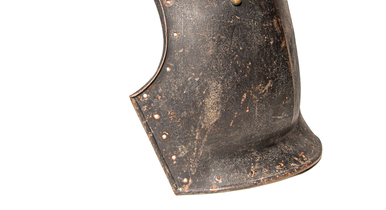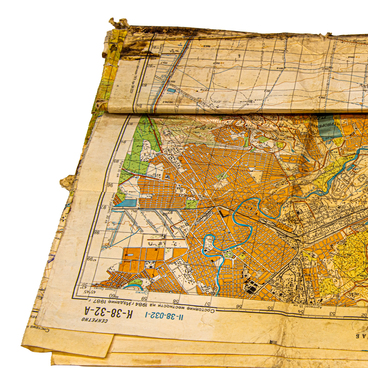Cuirassiers are the warriors of heavy cavalry that appeared in Europe in the 15th century. Cavalry warriors wore relatively inexpensive ‘laty’ (‘armor’) that covered two-thirds of the body, from head to knees. Hence their second, literal name — ‘the latniki’ (‘cuirassiers’). Military armor, the cuirass, consisted of the chest and dorsal curved plates and was shaped like a human body. In addition to the cuirass the helmet was an obligatory part of the cuirassiers’ uniform.
Cuirassiers first appeared in Russia in 1731. The Vyborg Dragoon Regiment was transformed into a cuirassier regiment at the suggestion of Russian Field Marshal Christopher Minich.
These cuirassier helmets were based on the pikelhelm, a pointed helmet that was personally designed by Emperor Nicholas I and the court painter, Major-General of His Imperial Majesty’s suite Lev Kil, at the turn of the 1830s and 1840s. The pikelhelm sketches were made based on the cuirassier helmet and the Old Russian helmet of earlier versions. It was later referred to as the ‘helmet of 1844’.
The Pickelhelm was made from a very strong pump leather coated with lacquer. The metal tip on the dome (shishak) was nicknamed the 'flaming grenada'.
There were two visors on the helmet — the front visor and rear visor and on the frontal part, there were chin straps with plates in the form of scales and the coat of arms according to the type of troops. There were two holes provided in the hollow tube on the tip for the head ventilation in the hot season. They opened and closed by turning the tube.
For the Guards cuirassier units and the Life Guards of the Gendarme squadron in 1845, there were introduced the helmets resembling the infantry model of 1844 instead of the traditional cuirassier helmets with a high horsehair crest. But already in 1846, they were replaced by hats made entirely of tombac — the copper and zinc alloy. The eagle figure on the front and the tip remained unchanged.
The Museum of Military Glory has a Russian cuirass and helmet of the 1846 sample, which were used during the Crimean War of 1853-1856. The 119th Kolomna Regiment was defending Sevastopol during these years.
These helmets were decorated with badges, coats of arms, and metal scales. In the Order’s cuirassier regiment, a St. George star made of yellow copper was attached to them, and the emblems on the frontal part of the helmet most often indicated the type of troops.
Cuirassiers first appeared in Russia in 1731. The Vyborg Dragoon Regiment was transformed into a cuirassier regiment at the suggestion of Russian Field Marshal Christopher Minich.
These cuirassier helmets were based on the pikelhelm, a pointed helmet that was personally designed by Emperor Nicholas I and the court painter, Major-General of His Imperial Majesty’s suite Lev Kil, at the turn of the 1830s and 1840s. The pikelhelm sketches were made based on the cuirassier helmet and the Old Russian helmet of earlier versions. It was later referred to as the ‘helmet of 1844’.
The Pickelhelm was made from a very strong pump leather coated with lacquer. The metal tip on the dome (shishak) was nicknamed the 'flaming grenada'.
There were two visors on the helmet — the front visor and rear visor and on the frontal part, there were chin straps with plates in the form of scales and the coat of arms according to the type of troops. There were two holes provided in the hollow tube on the tip for the head ventilation in the hot season. They opened and closed by turning the tube.
For the Guards cuirassier units and the Life Guards of the Gendarme squadron in 1845, there were introduced the helmets resembling the infantry model of 1844 instead of the traditional cuirassier helmets with a high horsehair crest. But already in 1846, they were replaced by hats made entirely of tombac — the copper and zinc alloy. The eagle figure on the front and the tip remained unchanged.
The Museum of Military Glory has a Russian cuirass and helmet of the 1846 sample, which were used during the Crimean War of 1853-1856. The 119th Kolomna Regiment was defending Sevastopol during these years.
These helmets were decorated with badges, coats of arms, and metal scales. In the Order’s cuirassier regiment, a St. George star made of yellow copper was attached to them, and the emblems on the frontal part of the helmet most often indicated the type of troops.



